Herculaneum (click on the name to go to Google sites about the town) is similar to Pompeii in that it is a buried city but it is also different in a number of important respects.
It was smaller (about 1/4 of the population) and only about 1/4 of the city is excavated. It is in better condition than Pompeii and as a visitor, you get a far better feel as to how a city worked. It also attracts fewer tourists.
By now, we are feeling more confident when we approach a site in that we are beginning to be able to “read a site”. However our guest lecturer and mentor (Alistair Small) is too polite to tell us if we have got it completely wrong and are talking rubbish! And so today, after an initial guided tour, we are being given some time on our own to go off and explore with our developing knowledge (not that it has ever been banned).
Once you have got past the helpful Information Point (no staff, no maps, no cafe, no seats (“do not sit on the floor”) but not “no entrance fee”)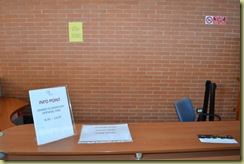
the image that greets you is quite astonishing
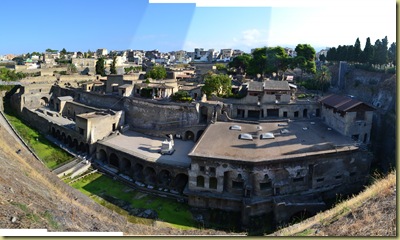
Laid out below you is a seemingly working city (without its original inhabitants).
![[AnnotatedMap-a.jpg]](https://blogger.googleusercontent.com/img/b/R29vZ2xl/AVvXsEjYGZZX7A_vTkvvC8JjlGBt-PJSI6DiXVPEfUD8UeKT2dVZlRKx7zUPSzURAx7WwxbcLZzphytLLNaA1WznUAaYef2BPYqE9YxF7GWdsIXd65qVf-9e3ElV-59oQ2J4fEv1FZzsbR85ECPm/s1600/AnnotatedMap-a.jpg) At the bottom of the plan (and also the photograph) is where the dockside originally was.
At the bottom of the plan (and also the photograph) is where the dockside originally was.
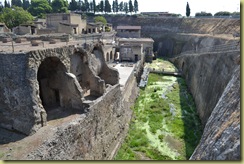
Ignore that it looks like a moat, it is now below sea level and pumps are constantly pumping water out. Apparently the water is full of bullfrogs but we did not see any.
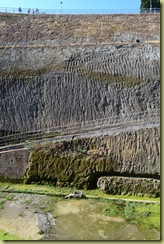
The town was covered by 20m of a different type of mud and ash to that at Pompeii and this photograph shows the thickness at the “sea shore”.
You get into the city either by crossing a bridge at the far end of the panorama photograph or (best choice) by going down a tunnel (again starting at the far end) which brings you out on the sea shore. Thus you enter the city as its seaborne inhabitants would have.
Once in the city, to the left is

a narrow alley that was one of the routes up from the docks and to the right is a plinth erected in memory of Marcus Nonius Balbo.
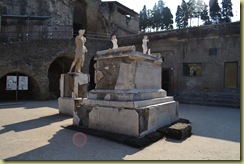
He was the city's major benefactor restoring and building many public buildings. On his death he was made patron and feted with many honours, detailed in the long inscription on his funeral altar.
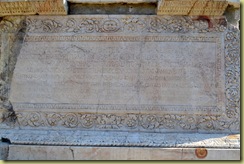
“In view of the proposal of Marcus Ofillius Celer, twice duumvir, that the dignity of the township required recognition of the merits of Marcus Nonius Balbus, the Council resolved the following: Seeing that Marcus Nonius Balbus, so long as he lived here showed a parental disposition of extraordinary generosity to individuals and the community, the councillors decided that an equestrian statue be erected to him at public expense in the most frequented spot with the inscription: 'To Marcus Nonius Balbus, praetor, proconsul, patron, (from) the entire Council of the people of Herculaneum in recognition of his merits. Further, at the spot where his ashes are laid a marble altar should be made and erected, and publicly inscribed: 'To Marcus Nonius Balbus son of Marcus' and that the procession of Parentalia should part from this spot, and that at the customary athletic games one day should be dedicated to his honour, and on the occasion of performances at the theatre a seat should be placed for him.
Resolved.
Many of the streets look like the original inhabitants have just gone inside for a few moments
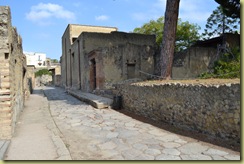
except perhaps for the lack of

rubbish.
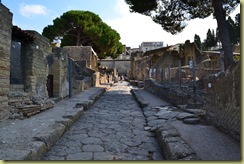
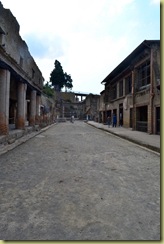
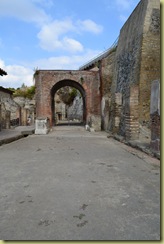
Above is the Decumanus Maximus – the main street which always runs East-West.
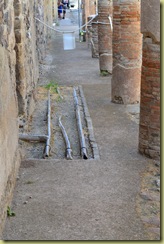
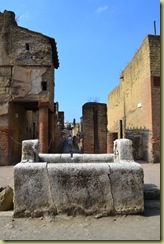
The old water system is evident with lead pipes under the pavement and a nice T off one into a house. On the old water tower (behind the water trough) in the right hand picture above
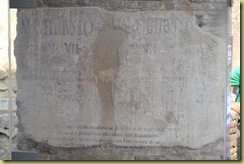
is a sign which says:
“Anyone who wants to shit in this place is advised to move along. If you act contrary to this warning, you will have to pay a penalty. Children must pay [number missing] silver coins. Slaves will be beaten on their behinds”
Exactly how literal a translation we do not know!
One can see how deep the ash was in the town by this first floor window which

still contains solid ash in the grill.
On the Decumanus Maximus is an advert for a wine shop with the original price list still on the wall. The sign reads “ad cumanas” which apparently means “go to the sign of the bowls”

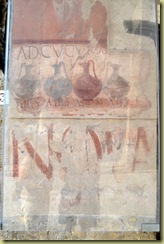
Closer examination of the price
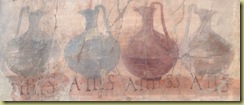
list shows the actual wine costs.
Nearby to the right of the House of Neptune and Amphitrite, (also known as the House of the Neptune Mosaic because of this mosaic
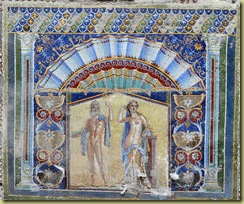
and also a rather fine frieze)
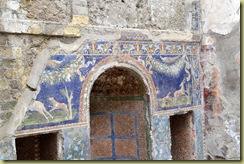
is a wine shop with original amphora
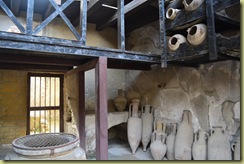
and partitions inside which survived the eruption.
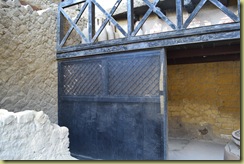
We do not know if it was the wine shop referred to in the street sign.
Off the Decumanus Maximus is a rather nice Domus (house) called the House of the Black Hall (Casa del Salone Nero) which must have been a cool haven off the street back in the AD70s.
Part of the original charred door and the lintel above it still remains.
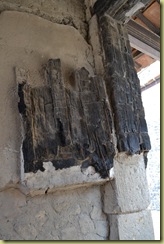
This was a large house
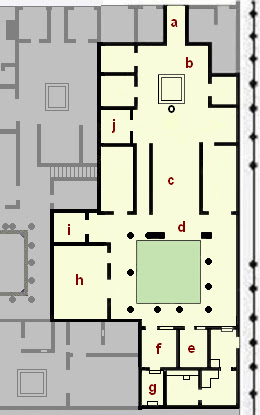
with a reasonably large peristyle
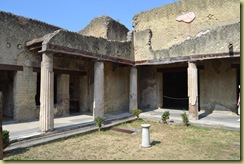
with a fountain in the middle.
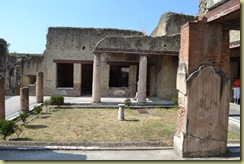
The house gets its name from a black room (fourth style)

with a rather nice floor. The general rule was nice floor = plain walls; flash walls = plain floor. The floor does not look much when it is dusty but clean it and (wow!). It is made up of lots of different and some quite rare marble.
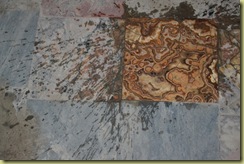
Not all houses were small. One house (The House of Argus) has a very large peristyle that has now been replanted with apple trees. It is quite astonishing to come across a house of this size within the middle of a small town.
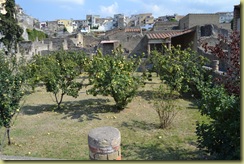
On the Decumanus Maximus is The House of the Augustan Cult
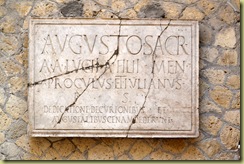
with an original plaque inside
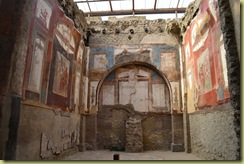
plus some rather nice frescoes
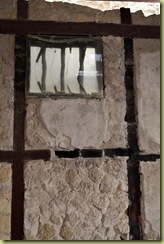
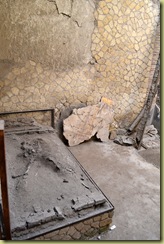
and to the right of the frescos is the caretakers room (window shown above left – the perspex is not original!) and inside the bed he was sleeping on when he died in the eruption – his bones being clearly visible.
The Samnite House has a nice atrium but this shows a couple of developments in atrium design. Because of restricted
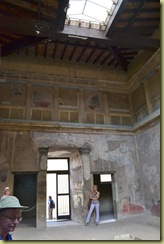
house plot size, the atrium is virtually on the street i.e you come in the front door off the street and almost immediately you are in the atrium which is of Tuscan design – this means that there is an
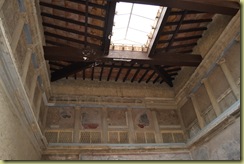
inward sloping roof supported by beams with gargoyles around
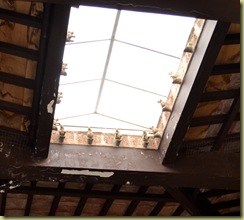
the opening. The compluvian is open to the air (the roof you can see in the picture is a modern addition for preservation reasons) and rain water discharges into the impluvium below.There are solid beams supporting the atrium roof. Some of the walls in this house show evidence of ancient (and possibly some modern) repair.

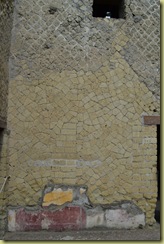
In a side room there are a few frescoes
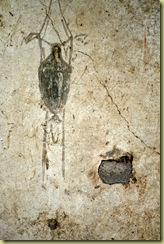
and here are a couple of fine
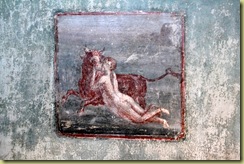
details from them.
There is a lot more on the site which we saw including the Male and Female Baths, the Palaestra and numerous other buildings – far too much to include here.
To finish Herculaneum, two rather nice frescoes which I show just because they are nice.
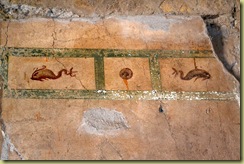

The bottom one particularly impresses us with the way that you can see through the drawn glass.
Boscoreale
Not too far away at Boscoreale is what used to be a farm house in the middle of the countryside – La Villa Regina. Now it is in the middle of

an estate of council flats and was discovered (1977) when the flats were being built. It has been rebuilt and some
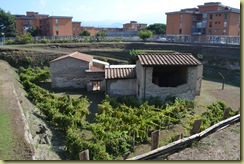
crops planted around it to give an idea of what a farm looked like and how it operated. Within the farm yard are a number of Dolio which are very large amphora (apparently about 600ltrs volume)
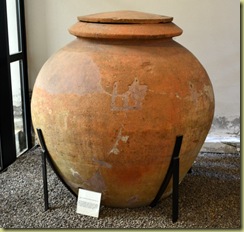
used for storing the olive oil, wine, wheat etc produced by the farm. These were quite valuable to farmers and often repaired when they were broken or damaged.
Unfortunately, the authorities have closed it indefinitely “for repairs” but there is no sign of repairs taking place, only grumpy curators who seem to be annoyed that you have come to the site and the attached museum – L’Antiquarium. Click here to go to the Google sites pages on the Villa Regina and see pictures of the inside.

Outside of the museum are some tree roots from the time of the eruption – strange to touch a tree over 2000 years old.
Inside the museum are a large variety of items related to the eruption period (tools, food, everyday items) and it could be interesting had the museum taken more care on labelling its exhibits (and the staff tried to look welcoming rather than scowl the whole time). Being the only visitors there that day, we had a good chance to walk around. Amongst the more unusual exhibits was

this Dormouse Pot – used for keeping and breading dormice. Dormice were a delicacy and often eaten as part of a first course.

Inside the pot is a pouch for food and a ramp around the inside for the mice to get up and down the pot to their food.
Recipe for cooked dormouse:
Skin then stuff them with a mixture of pork mince, dormouse meat trimmings, pepper, nuts, asafoetida (a sort of giant fennel aka devil’s dung or stinking gum) and garum (a very pungent fish sauce) and then roast – two per person.
Of somewhat macabre interest are
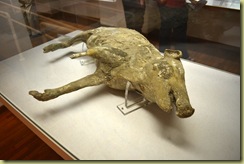
a number of bodies recovered from the Pompeii area. Including this pig
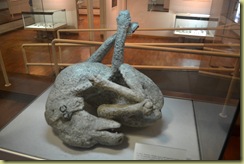
a dog which was chained up at the time of the eruption
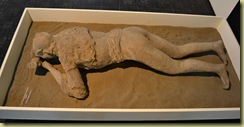
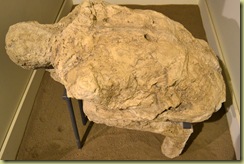

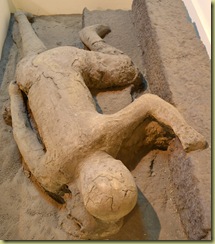
and four bodies whose positions tell their story. Note the clothes on the body in the top photograph.
The morning was very interesting, the afternoon less so, simply because of the attitude of the museum.

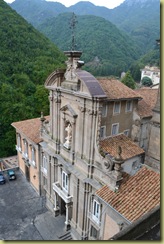
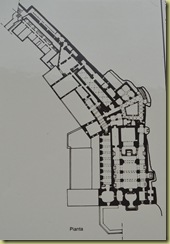


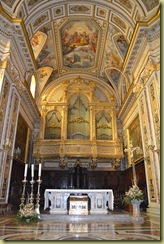
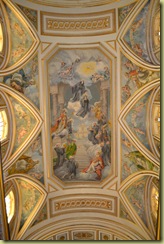
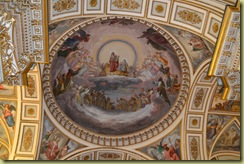
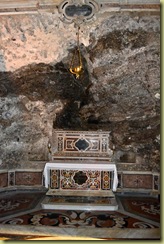

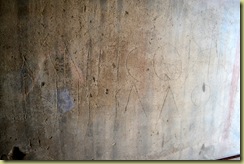

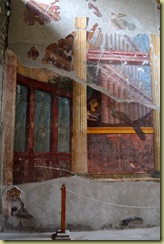
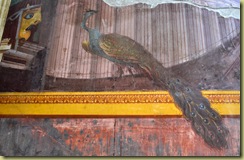


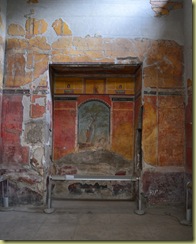
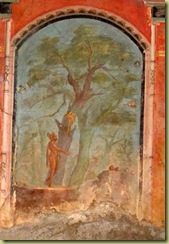
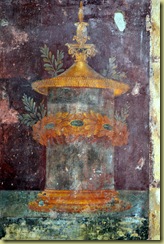
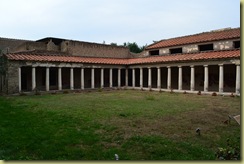

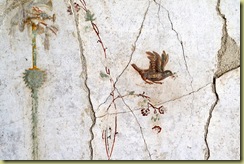

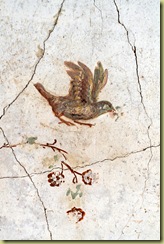
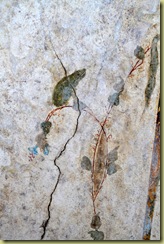
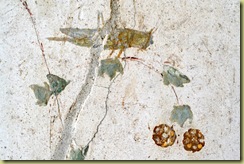
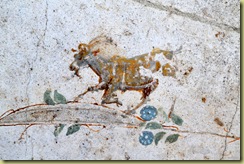
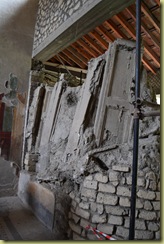
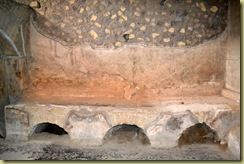

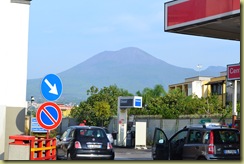
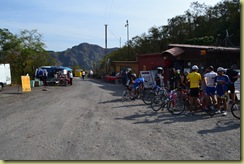
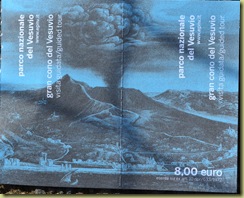
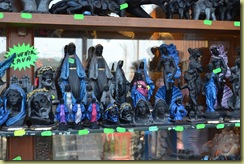
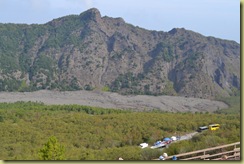
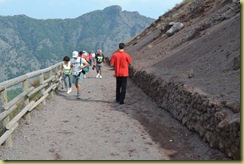
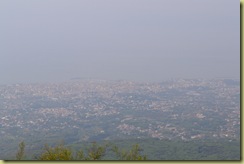
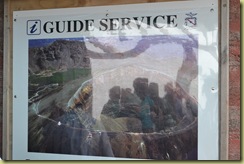
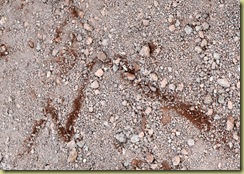

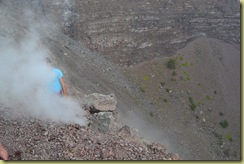
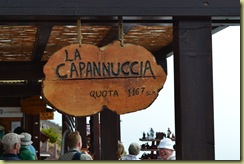


![[AnnotatedMap-a.jpg]](https://blogger.googleusercontent.com/img/b/R29vZ2xl/AVvXsEjYGZZX7A_vTkvvC8JjlGBt-PJSI6DiXVPEfUD8UeKT2dVZlRKx7zUPSzURAx7WwxbcLZzphytLLNaA1WznUAaYef2BPYqE9YxF7GWdsIXd65qVf-9e3ElV-59oQ2J4fEv1FZzsbR85ECPm/s1600/AnnotatedMap-a.jpg) At the bottom of the plan (and also the photograph) is where the dockside originally was.
At the bottom of the plan (and also the photograph) is where the dockside originally was.



















































